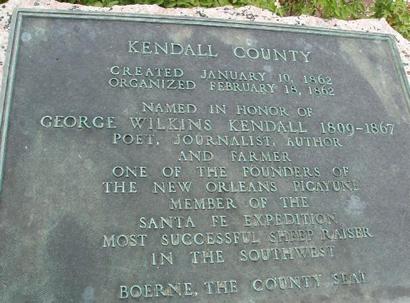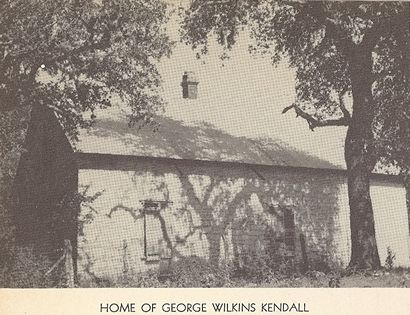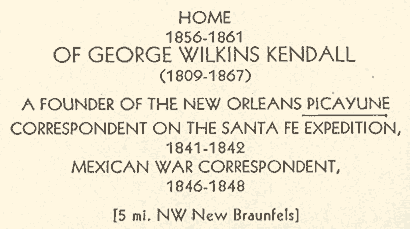George Wilkins Kendall. (original) (raw)
| by Clay Coppedge |  |
|---|
The man for whom Kendall County is named is credited with being America�s first war correspondent and the father of the sheep business in Texas. Even without those notations in the state�s history, we would know him as a survivor and chronicler of the ill-fated Santa Fe Expedition.

George W. Kendall was born in New England where he learned the printing trade and drifted south, eventually ending up in New Orleans where he helped found the New Orleans Picayune, a daily newspaper described as �a saucy little sheet which sold for the price of a Spanish coin called a picayune that was worth 6 � cents.�
| Kendall took on the role of correspondent and signed up for what sounded like a good story and a rousing adventure: an expedition to Santa Fe that would claim New Mexico for Texas. Mirabeau Lamar, the second president of the Republic of Texas, sent the men on their way toward his version of manifest destiny despite the fact that Congress hadn�t signed off on the deal. The story took an ugly turn when Lamar�s soldiers of fortune were captured by Mexican authorities and marched off to Mexico City where they were imprisoned in a leper colony. | | | ----------------------------------------------------------------------------------------------------------------------------------------------------------------------------------------------------------------------------------------------------------------------------------------------------------------------------------------------------------------------------------------------------------------------------------------------------------------------------------------------------------------------------------------------------------------------------------- | |
Out of that experience came Kendall�s first book, �Narratives of the Texas Santa Fe Expedition.� The book was a best seller and remains in print today. J. Frank Dobie considered the book �journalistically verbose� but most critics give it high marks as one of the best campaign narratives ever written.
Kendall was eventually released from prison and made his way back to New Orleans, where his book was serialized in the Picayune. He used the newspaper to drum up support for a war with Mexico, and when that came to pass he served as a correspondent, riding and reporting with Ben McCullough�s Texas Rangers and as an aide de camp to Gen. William Worth, for whom Fort Worth is named.
Kendall used the Pony Express along with ships and the telegraph to get his stories back to New Orleans, immortalizing himself in the process as the country�s first true war correspondent. He was on the scene when McCullough�s troops stormed Monterrey and he was there at the landing of Veracruz and the Mexico City campaign.
A book about his experiences in the war with Mexicoalso sold briskly. Kendall went to Europe and met his wife-to-be, Adeline de Valcourt, in France. The couple lived in that country for several years and it was in France that Kendall started studying sheep breeding and raising in earnest.
Six years after the Kendalls moved to Texas, in 1861, George bought the Post Oak Ranch near Boerneand did much to promote and expand the sheep industry. In a sketch of Kendall written for the National Society of the Daughters of the American Revolution, Frances Lipe wrote:


Home (1856-1861) of George Wilkins Kendall
1936 illustration courtesy Sarah Reveley
�The greatest innovation Kendall gave to the sheep industry was crossbreeding the Mexican Churro ewes with the fine-fleeced Merinos, to produce a new strain with the stamina needed for the Texas hill country and the fine wool of the Merinos.�Not only were they prolific in breeding, but they increased wool production dramatically.� He found that the local Germans made excellent shepherds.� He paid them in sheep and taught them the skills of sheep ranching.� Thus, they built the sheep industry to its present day huge proportions in this area.�
Kendall kept writing, including some reminisces of his colorful life on the frontier, but mostly he wrote about sheep, including a book on sheep husbandry written with business partner Henry S. Randall.
After Kendall died of pneumonia in 1867, Randall wrote of him, �He loved Texaswith an absolute devotion.� He never was tired of writing or speaking in its praise.� He loved its vast expanses of solitude, its majestic plains, its noble rivers, the green hills of the county named after him, and its masculine energetic population.
�George Wilkins Kendall earned his place as the father of the Texas sheep industry through hard work and energetic promotion of that industry.� He did Texasand the sheep industry a great service.�
Through his writing, particularly his account of the Santa Fe Expedition, Kendall did his adopted statea great service as well.
� Clay Coppedge "Letters from Central Texas"
December 1, 2009 Column